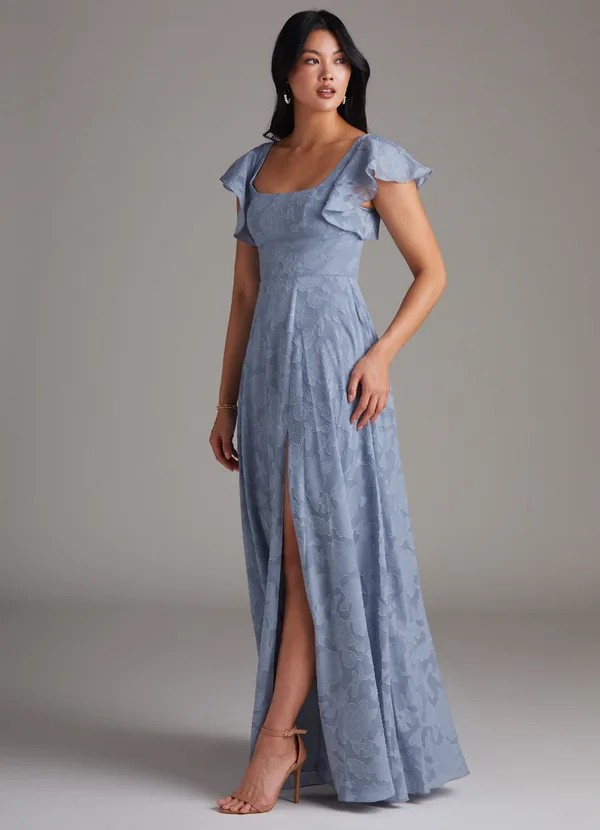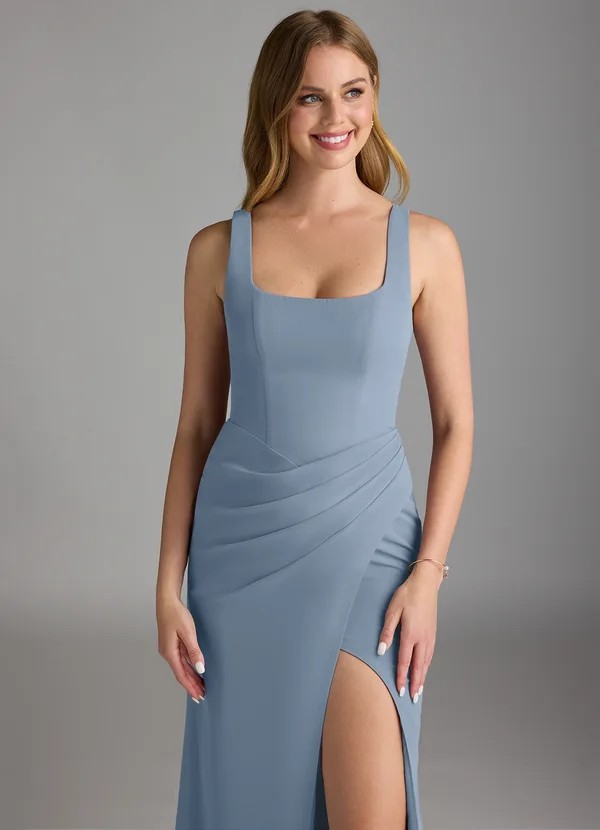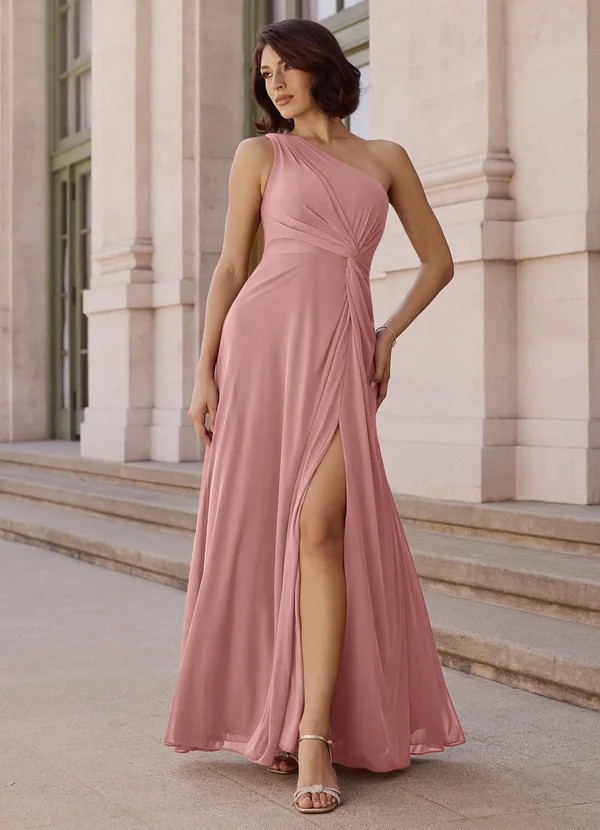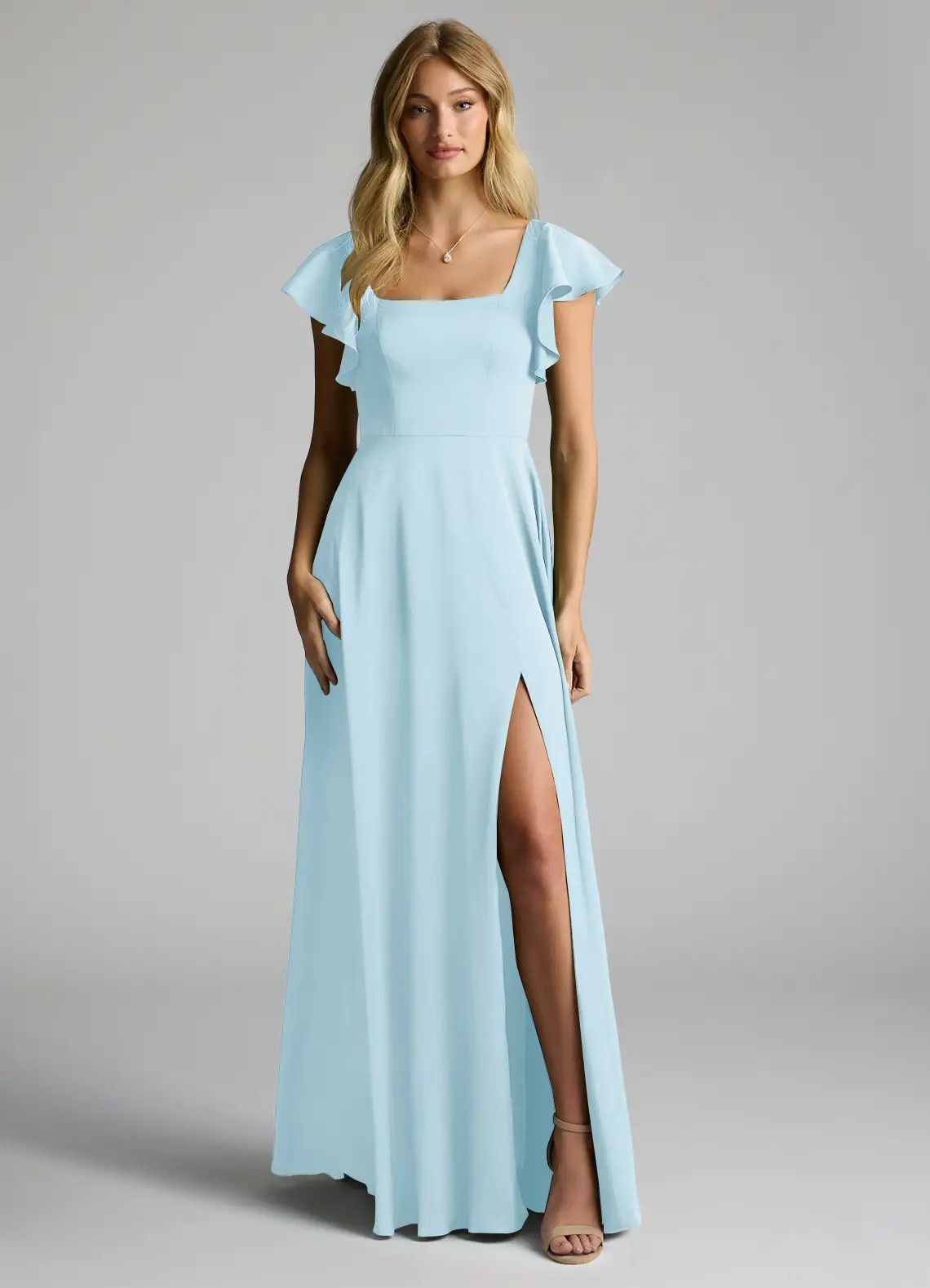What Is the Ideal Length for a Bridesmaid Dress?

The ideal length for a bridesmaid dress depends on wedding formality and venue type. Floor-length gowns suit formal weddings and evening events, while tea-length works for semi-formal and outdoor settings.
Most bridesmaids choose floor-length dresses that hit 1 inch above the floor with heels. Allow 2-3 fittings over 4-6 weeks for proper hem adjustments. Order dresses 8-10 weeks before the wedding date.
Bridesmaid Dress Length Comparison
| Length Type | Measurement | Best For | Formality Level | Alteration Ease |
| Floor-length | 1 inch above floor with heels | Evening weddings, formal venues | Formal, black-tie | Requires professional hem |
| Ankle-length | Hits at ankle bone | Semi-formal events | Formal to semi-formal | Moderate alterations |
| Tea-length | Mid-calf (15-17 inches from floor) | Daytime, outdoor weddings | Semi-formal | Easy to alter |
| Knee-length | Just above or at knee | Casual, daytime weddings | Semi-formal to casual | Minimal alterations |
| Cocktail | 2-4 inches above knee | Casual receptions, parties | Casual | Very easy to alter |
Step 1: Choose Length by Wedding Formality

Black-Tie & Formal Weddings
Floor-Length Gowns (Required):
- Touches the floor with 1 inch clearance
- Most elegant and traditional option
- Worn with 2.5-3.5 inch heels
- Requires professional hemming
Why This Length: Black-tie dress codes demand formal floor-length gowns. Shorter lengths appear too casual for evening formal events.
The dress should graze the top of your shoes. Too long creates tripping hazards; too short looks unfinished.
Fabric Considerations:
- Heavy satins and silks drape elegantly
- Chiffon overlays create movement
- Structured fabrics hold shape better
- Avoid clingy materials at this length
Semi-Formal Weddings
Best Length Options:
- Floor-length (most popular choice)
- Tea-length (mid-calf, vintage feel)
- Ankle-length (modern, clean look)
Flexibility Allowed: Semi-formal dress codes offer more length flexibility. Coordinate with other bridesmaids for a cohesive look.
Daytime semi-formal events can feature tea-length dresses. Evening semi-formal typically stays floor-length.
Venue Matching:
- Ballrooms: floor-length preferred
- Gardens: tea-length works beautifully
- Restaurants: knee or tea-length appropriate
- Country clubs: any length within semi-formal range
Casual & Daytime Weddings

Versatile Length Choices:
- Tea-length (most popular for casual)
- Knee-length (comfortable, playful)
- Cocktail length (for very casual events)
- Floor-length still acceptable
Practical Benefits: Shorter lengths offer comfort and mobility. Perfect for outdoor venues with uneven surfaces.
Bridesmaids can rewear these dresses more easily. Less fabric means easier alterations and lower alteration needs.
Style Guidelines:
- Light, flowy fabrics work best
- A-line or fit-and-flare silhouettes
- Avoid overly formal details
- Match length to venue formality
Step 2: Factor in Season & Weather
Spring Weddings (March-May)
Ideal Lengths:
- Tea-length (light and fresh)
- Floor-length (for formal spring events)
- Knee-length (for casual celebrations)
Seasonal Considerations: Spring weather varies from cool to warm. Lighter fabrics in any length work best.
Outdoor spring weddings suit tea-length for unpredictable ground conditions. Indoor events can feature any length based on formality.
Fabric & Length Pairing:
- Chiffon: any length, flows beautifully
- Lace: tea or knee-length for spring garden feel
- Light satin: floor-length for elegance
- Jersey: comfortable at any length
Summer Weddings (June-August)
Ideal Lengths:
- Tea-length (breathable, comfortable)
- Knee-length (coolest option)
- Floor-length (for evening formal events)
Heat Considerations: Shorter lengths keep bridesmaids cooler in summer heat. Less fabric touching skin means better airflow.
Floor-length works for air-conditioned venues. For outdoor summer weddings, choose tea or knee-length.
Practical Tips:
- Avoid heavy, floor-length fabrics in heat
- Choose lightweight materials at any length
- Consider high humidity with floor-length hems
- Shorter lengths photograph well in bright sun
Fall Weddings (September-November)

Ideal Lengths:
- Floor-length (classic fall elegance)
- Tea-length (versatile for weather changes)
- Ankle-length (modern fall look)
Weather Flexibility: Fall weather transitions from warm to cool. Floor-length provides coverage for cooler evenings.
Tea-length works for warmer fall days. Any length pairs well with wraps or shawls.
Styling Considerations:
- Richer, heavier fabrics suit floor-length
- Velvet and satin work beautifully at full length
- Deeper colors look elegant in any length
- Outdoor venues may still need shorter lengths
Winter Weddings (December-February)
Ideal Lengths:
- Floor-length (provides warmth and elegance)
- Ankle-length (formal, covers legs)
Cold Weather Benefits: Longer dresses offer more coverage and warmth. Floor-length is practical and formal for winter events.
Avoid very short lengths unless venue is warm. Extra fabric provides insulation during photos and travel.
Winter Styling:
- Pair with tights or hosiery under longer lengths
- Add wraps or shawls for outdoor portions
- Heavier fabrics work well at floor-length
- Rich textures enhance winter elegance
Step 3: Match Length to Body Type
Petite Bridesmaids (Under 5’4″)
Most Flattering Lengths:
- Floor-length with proper hemming
- Ankle-length (elongates legs)
- Avoid tea-length (can shorten appearance)
Alteration Requirements: Floor-length dresses need significant hemming for petite frames. Budget 2-3 inches minimum for alterations.
Choose dresses without heavy bottom embellishments. Cutting through beading or lace costs more and may look unfinished.
Styling Tips:
- Wear highest comfortable heel
- Avoid ankle straps (shortens leg line)
- High waistlines elongate body
- Vertical seams add height
Tall Bridesmaids (Over 5’9″)

Most Flattering Lengths:
- Floor-length (shows off height beautifully)
- Ankle-length (modern, showcases legs)
- Tea-length (can appear shorter than intended)
Alteration Considerations: Standard dresses may run short on tall frames. Order extra length if available, or choose midi styles.
Tea-length dresses may hit at awkward spots. Knee-length can appear too short and unbalanced.
Styling Guidelines:
- Floor-length is most proportional
- Ensure dress isn’t custom-shortened already
- Check inseam measurements before ordering
- May need custom or tall sizing
Plus-Size Bridesmaids
Most Flattering Lengths:
- Floor-length (elongates figure)
- Ankle-length (clean, modern line)
- Avoid mid-calf (can cut figure unfavorably)
Proportion Tips: Floor-length creates a long, unbroken line that flatters curves. Avoid lengths that hit at the widest part of calves.
A-line silhouettes in floor-length work best for most plus-size figures. The length balances proportions beautifully.
Fabric Considerations:
- Flowy fabrics skim curves at any length
- Structured materials provide support
- Avoid clingy fabrics in shorter lengths
- Floor-length offers most versatility
Hemming & Alteration Guide
Proper Floor-Length Measurement
Standard Measurement Process:
- Wear wedding-day heels to fitting
- Dress should hover 1 inch above floor
- Walk forward and backward to test
- Check from all angles (front, back, sides)
Common Mistakes: Hemming too short makes dress appear casual. Too long creates tripping hazard and fabric damage.
Different heel heights change hem dramatically. Always bring exact shoes to fittings.
Professional Alterations:
- First fitting: mark hem with pins
- Second fitting: check stitched hem
- Final fitting: verify with movement tests
- Allow 3-4 weeks for hem alterations
Tea-Length Measurement Standards
Ideal Tea-Length Placement:
- Mid-calf, typically 15-17 inches from floor
- Shows ankle and lower calf
- Hits at slimmest part of calf
- Measures with 2-3 inch heels
Why Exact Placement Matters: Too high looks like a mistake; too low appears awkward. The right spot flatters leg shape.
Measure from floor to desired length. Mark both front and back of dress at fittings.
Alteration Ease: Tea-length alterations are simpler than floor-length. Less fabric to remove means faster turnaround.
Can adjust 2-3 inches up or down easily. Works well for bridesmaids of varying heights.
Knee-Length Precision

Standard Knee-Length:
- Hits just above or at kneecap
- Typically 20-22 inches from floor
- Shows most of leg
- Requires 1-2 inch heels minimum
Fitting Guidelines: Sit down during fitting to check comfort. Dress shouldn’t ride up too high when seated.
Stand and bend to ensure adequate coverage. Walk to verify hem stays in place.
Minor Adjustments: Knee-length needs minimal alterations. Most dresses fit well with 1-2 inch changes.
Easier to DIY hem if needed. Less expensive alteration category overall.
Length Timeline & Ordering
Weeks Before Wedding
Initial Decisions:
- Choose dress length based on venue
- Coordinate length with bridal party
- Confirm formality with bride
- Order dresses in chosen length
Considerations: Some designers offer multiple length options. Others require custom hemming post-delivery.
Standard lengths usually mean floor-length. Specify if you want tea or knee-length at order.
Weeks Before Wedding
First Fitting Stage:
- Receive dress and inspect
- Schedule fitting appointment
- Bring wedding-day shoes
- Discuss length with seamstress
What to Expect: Seamstress will pin desired length. Try walking, sitting, and moving around.
Floor-length typically needs adjustment. Tea and knee-length may fit with minor changes.
Weeks Before Wedding
Alteration Completion:
- Attend second fitting
- Check hemmed length
- Verify with shoes and movement
- Approve final length
Final Checks: Walk on different surfaces if possible. Sit and stand multiple times.
Check front and back hem alignment. Ensure length is consistent all around.
Weeks Before Wedding
Final Pickup:
- Collect altered dress
- Do final try-on with all accessories
- Confirm length is perfect
- Store dress properly
Last-Minute Issues: If length still seems off, address immediately. Some seamstresses offer quick adjustments.
Minor hem fixes take 2-3 days. Major changes require 1 week minimum.
Mixed-Length Bridal Parties

When Mixed Lengths Work
Coordinated Variety:
- All tea-length or all knee-length (cohesive)
- Intentional mix (maid of honor different length)
- Same dress style, different lengths
- Coordinated by bride’s vision
Benefits of Mixing: Accommodates different body types and preferences. Creates visual interest in photos.
Practical for venues with mixed indoor/outdoor. Allows personal comfort choices.
Guidelines for Success:
- Keep formality consistent across lengths
- Use same fabric and color
- Coordinate with bride first
- Ensure all lengths are intentional, not mistakes
When to Avoid Mixed Lengths
Formal Weddings:
- Black-tie events need uniformity
- Traditional venues expect matching
- Creates cohesive formal appearance
- Mixed lengths can look unplanned
Photography Concerns: Very different lengths (floor and knee) can look mismatched in photos. Creates unbalanced visual lines.
Best to stay within one length category. All floor or all tea works better than mixing both.
Frequently Asked Questions
Can bridesmaids wear different dress lengths?
Yes, bridesmaids can wear different lengths if the bride approves. Keep lengths within the same category (all tea or all floor) for cohesion.
Mixed lengths work best for casual or semi-formal weddings. Formal and black-tie events typically require matching floor-length gowns for a unified appearance.
How much should a floor-length bridesmaid dress be hemmed?
A floor-length dress should hover 1 inch above the floor when wearing wedding-day heels. This prevents tripping and fabric damage while maintaining elegant length.
Bring exact shoes to all fittings. Hem height changes significantly with different heel heights. Most floor-length dresses need 2-4 inches hemmed for average height.
Is tea-length appropriate for evening weddings?
Tea-length works for semi-formal evening weddings but not black-tie events. Check the dress code and venue formality first.
Indoor formal venues typically call for floor-length regardless of time. Outdoor evening receptions can feature tea-length if the overall vibe is relaxed.
What length bridesmaid dress makes you look taller?
Floor-length and ankle-length dresses create the longest line and most elongating effect. The unbroken vertical line from shoulder to floor adds height.
Avoid tea-length and mid-calf lengths if you want to appear taller. These lengths can visually shorten the leg line, especially on petite frames.
Should bridesmaid dress length match the wedding gown?
Bridesmaid dress length doesn’t need to match the wedding gown length. The bride typically wears floor-length regardless of bridesmaid choices.
Coordinate formality levels instead of exact length. If the bride wears a dramatic ball gown, bridesmaids should wear formal floor-length dresses for balance.
Can you alter a floor-length dress to tea-length?
Yes, floor-length dresses can be altered to tea-length. This alteration is straightforward and costs less than lengthening.
Consider dress details before cutting. Hem embellishments, beading, or lace may be lost. Some dresses have tiered designs that don’t work shortened.